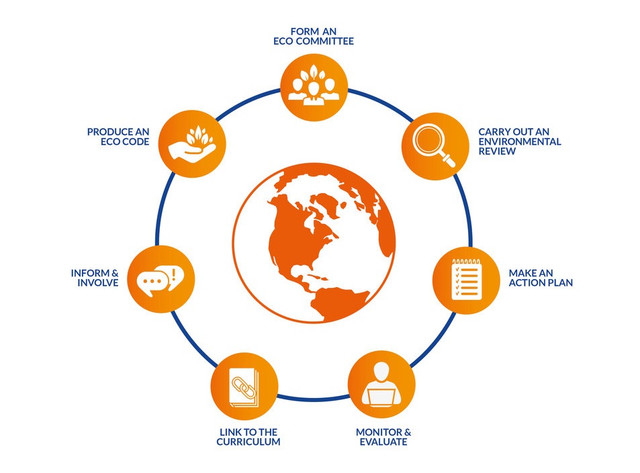The Seven Step Framework

Start Your Journey
The Eco-Schools Seven Steps method is a comprehensive guide that helps schools implement sustainable practices and engage students in environmental stewardship. This guidelines thoughtfully designed series of actions aimed at enhancing schools’ success in achieving their Eco-School goals. It entails the active participation of various members from the school community, with students taking a central part.
Method 1 : Form an Eco Committee
The primary force behind the programme initiative and the selected committee will represent the school’s collective viewpoint.
- Led by students.
- Responsible for ensuring that the entire school is aware of Eco-Schools and receives regular updates.
- The composition of the Eco Committee may include students, teachers, the principal, non-teaching staff (such as the secretary, caretaker, cleaner), parents, members of the Board of Management, as well as interested and pertinent members from the broader community.
- Convenes on a regular basis to deliberate on environmental and social initiatives for the school.
Method 2 : Carry out a Sustainability Audit
Assists the school in recognizing its present environmental and social influence, highlighting positive aspects as well as areas needing improvement.
- Aim is to investigate the environmental and social issues in your school or community.
- All main themes should be reviewed annually (the school is free to also choose other areas of concern that are more relevant to its needs and to devise appropriate checklists accordingly).
- Make sure that the wider school community works as closely as possible with the Eco Committee to carry out the Review. It is essential that as many students as possible participate in this process.
- Results of your Sustainability Audit will inform your Action Plan.
Method 3 : Action Plan
Forms the central aspect of your Eco-Schools endeavors and should be created based on the outcomes of your Sustainability Audit.
- Use the Sustainability Audit to identify the priority areas in your school. To keep it manageable we suggest focusing on not more than three Themes at a time.
- Create an Action Plan to resolve or improve those problems include: the necessary tasks, the people responsible and time frame for actions in order to achieve your goals/targets
- Make your action plan SMART (specific, measurable, attainable, realistic and timely)
- Students should be involved as much as possible in the drawing up of the Action Plan.
Method 4 : Monitor and Evaluate
To determine the success of your progress towards the objectives outlined in your Action Plan, it is essential to consistently monitor and measure your advancements.
- Student should be given the responsibility for carrying out monitoring activities wherever possible.
- Results of monitoring should be regularly updated and displayed for the whole school to see
- The monitoring methods that you use will depend on the targets and measurement criteria decided on in your Action Plan for the topics you wish to look at and the age and ability of the students and other individuals who carry it out
- Evaluation follows on from monitoring. Evaluating the success of your activities will allow you to make changes to your Action Plan if required.
Method 5 : Curriculum Work
In addition to elevating the programme’s stature, aligning Eco-Schools activities with the curriculum guarantees a genuine integration of Eco-Schools within the school community.
- Integrating the programme into the curriculum can be done, either directly through specific classes or innovative teaching
- Students from throughout the school should gain an understanding of how real life environmental and social issues are dealt with in a real life setting
Method 6 : Inform and Involve
Ensuring widespread participation and Actions should extend beyond the school environment; for instance, students should carry home ideas to implement in their own settings.
- It is essential that the whole school is involved in, and the wider community aware of, the schools’ Eco-Schools programme.
- Means of information provision and public relations to tell about their work can include: school assemblies, school notice boards, school newsletters and websites, school plays, dramas and fashion shows based on environmental and social issues, letters to businesses and corporations, local and national press, radio and television, etc.
Method 7 : Produce an Eco Code
A declaration illustrating the school’s dedication to promoting sustainability.
- Unique and familiar to everyone in the school
- Format is flexible, it can be a song, drawing, model, poem, etc.
- List the main objectives of your Action Plan
- It is crucial that pupils play a key role in the development of the Eco Code, as this will give them a greater sense of responsibility towards the values the Eco Code represents
- Content should be reviewed on a regular basis to ensure that it continues to reflect the school's ecological aims and targets
- Prominently displayed throughout the school
